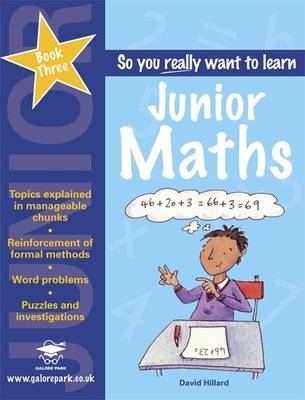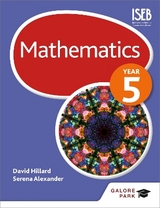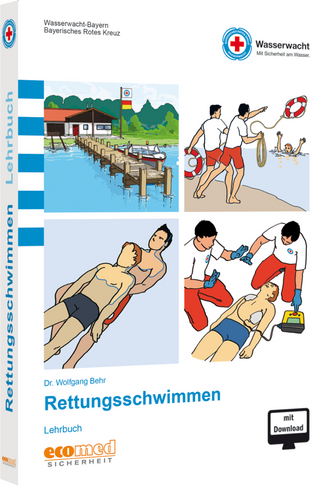
Junior Maths Book 3
Galore Park Publishing Ltd (Verlag)
978-1-905735-26-6 (ISBN)
- Titel erscheint in neuer Auflage
- Artikel merken
Junior Maths Book 3 is a rigorous and challenging textbook for pupils aged 9+ (Year 5 upwards) and helps pupils to prepare for success at Common Entrance. This book consolidates the material already covered in the Junior Maths course and introduces new topics such as percentages, ratio and proportion, line graphs and probability, all of which will lay the foundations for success in Common Entrance and other entrance exams at 11+. - Covers the new numeracy framework to ensure pupils are learning the most up to date material - Combines the traditional standard method with the mental approach to challenge all abilities and satisfy all needs - Includes a huge bank of practice material including problem solving exercises to ensure pupils have plenty of practice material The Answer Book is now available as a free download. Also available from Galore Park www.galorepark.co.uk: - Junior Maths Book 1 - Junior Maths Book 2 - 11+ Maths Practice Exercises - 11+ Maths Practice Exercises Answer Book - 11+ Maths Revision Guide
David Hillard has spent more than 45 years teaching mathematics in two preparatory schools. Since 1980 he has been associated with the Common Entrance examination at 11+, 12+ and 13+ levels in the role of either advisor, assessor or setter. He played a significant part in the revision of the syllabus in 2003 when the present format of the Common Entrance examination was introduced.
Please note that this contents listing is not final. Chapter 1: The calculator Introduction Use of [+], [-], [x], [/], [=] Decimal point in calculation Changing a wrong entry Recognize negative outcome Use of brackets Calculating 'real life' problems Interpret recurring decimals Use to check answers Use of approximation to check answer End of chapter activity: TBC Chapter 2: A million Place value Writing in words and figures End of chapter activity: TBC Chapter 3: Factors What they are Rules of divisibility Finding a pair of factors Square numbers, vs, and use of Prime numbers Prime factors End of chapter activity: TBC Chapter 4: Exploring numbers A general revision of number properties End of chapter activity: TBC Chapter 5: Decimal, fraction and percentage relationship Writing decimals as fractions Writing fraction as decimals Writing decimal as percentages Writing percentages as decimals Writing percentages as fractions Writing fractions as percentages Summary of all relationships End of chapter activity: TBC Chapter 6: Percentages 100% as total 10% of quantities Further percentages of quantities End of chapter activity: TBC Chapter 7: Parts of a whole A fraction of a quantity A quantity as a fraction of another End of chapter activity: TBC Chapter 8: Ratio and proportion Ratio (1 for every) Proportion (1 in every) End of chapter activity: TBC Chapter 9: Functions 2 functions including inverse Use of words "Think of a number..." End of chapter activity: TBC Chapter 10: Inequalities Introduction of < and > End of chapter activity: TBC Chapter 11: Negative numbers Addition and subtraction End of chapter activity: TBC Chapter 12: Decimal multiplication By single digit only End of chapter activity: TBC Chapter 13: Decimal division By single whole number digit only With remainder as whole number, Fraction and decimal End of chapter activity: TBC Chapter 14: Long multiplication By factors 2 digits by 2 digits Problem solving End of chapter activity: TBC Chapter 15: Division by factors No remainders Problem solving End of chapter activity: TBC Chapter 16: Angles Measuring angles exactly Drawing angles exactly Angles on a straight line Sum of angles of triangle Angles of isosceles and equilateral ? End of chapter activity: TBC Chapter 17: Translation Plotting translations Describing translations End of chapter activity: TBC Chapter 18: Rotation Rotation of 90 /180 about a vertex Rotational symmetry End of chapter activity: TBC Chapter 19: Area Find formula for area Apply to rectangle, square, composite Shape, right angled triangle End of chapter activity: TBC Chapter 20: 3D figures Nets of cuboid, cube, ? prism Pyramid Area of above Basic volume End of chapter activity: TBC Chapter 21: Line graphs Continuous line (conversion, travel) Broken line (temperature) End of chapter activity: TBC Chapter 22: Statistic frequency Graphical representation Range Mode Median Mean End of chapter activity: TBC Chapter 23: Probability Meaning Words: chance, certain, impossible, likely, unlikely, evens Numerical answers from given data Examples of probable outcomes End of chapter activity: TBC Chapter 24: Mental strategies
| Erscheint lt. Verlag | 10.8.2009 |
|---|---|
| Verlagsort | Tenterden |
| Sprache | englisch |
| Maße | 190 x 246 mm |
| Gewicht | 742 g |
| Themenwelt | Schulbuch / Wörterbuch |
| ISBN-10 | 1-905735-26-X / 190573526X |
| ISBN-13 | 978-1-905735-26-6 / 9781905735266 |
| Zustand | Neuware |
| Haben Sie eine Frage zum Produkt? |
aus dem Bereich



